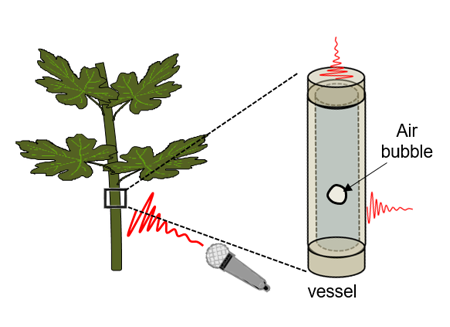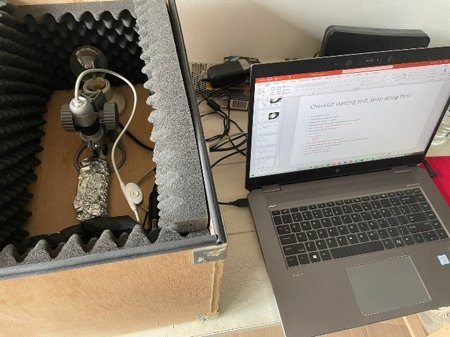Authors: Satadal Dutta and Gerard Verbiest, Department of Precision and Microsystems Engineering, Delft University of Technology.
Can we hear a plant’s distress call when it needs watering or when it is physically damaged? Can we diagnose a plant’s condition by sound, to check for stress? As precision and microsystem engineers, we are interested in exploring these objectives within the Plantenna consortium.
Ultrasonic sound emission
In collaboration with our partners at Wageningen University and Research, we began in October 2019, to study the phenomenon of sound emission from drought-stressed shoots of plants, known to originate from microscopic water-carrying vessels (xylem) hidden inside the stem. These bursts of sound are of low intensity and contains ultrasonic frequencies, which makes them inaudible to humans, but can be recorded with a commercial microphone. Interestingly, we found that analysing the characteristics of individual sound bursts could provide information about the size and stiffness of the vessel. These parameters are crucial in determining the physical health of the plant.
The logical follow-up questions were: How could one further use ultrasound as a non-invasive tool to monitor the plants in real time, and across different plant species ? How can physics help us further in unravelling the exact sources of these ultrasound ? “Sounds” like a Plantenna challenge!
Despite COVID restrictions, our motivated students at TU Delft (both BSc and MSc) have come forward to pursue these research questions. Work from home? No problem. Although social distancing resulted in less sound and noise from people, it created a good environment to listen to the sound of plants instead. A group of BSc students built and tested a set-up where we can excite a cut segment of a plant stem with an attached ultrasound transmitter in different orientations. They studied how the characteristics of the received sound pulse change with varying water content in the stem. The work will be further developed by our new MSc student Berend de Klerk, as part of his High-Tech Engineering track at TU Delft. He wants to study the ultrasound response from intact plants in a controlled environment. The results will be benchmarked against data from independent sensors in a greenhouse, which measure external variables e.g. temperature, humidity, soil water potential and ambient light intensity.

Drought-stress leads to bubble formation in water-carrying plant vessels and generate sound bursts.
3D printed plant vessels
Thijs Bieling, another of our Msc student (High-Tech Engineering track) has taken up the challenge of a detailed experimental study of the origin and properties of vascular ultrasound emissions. His goal is to create artificial tiny vessels of a plant with the help of 3D printing (with tubes as thin as half a micrometre) and emulate the process of water-loss from these structures. He is monitoring the process using both optical microscopy and ultrasound microphone. By inducing evaporation on these structures we can observe the intricate draining methods and the accompanying acoustic emissions of these artificial xylem vessels. His goal is to validate and propose advanced models for vessel-parameter extraction in plants, bringing us one step further to a deeper understanding of plant-sound relations!

Thijs Bieling and his chamber of secrets. A dedicated enclosure with acoustic isolation and temperature control to observe and listen to the 3D printed xylem vessels.
Team
- Thijs Bieling (MSc TU Delft)
- Satadal Dutta (TU Delft)
- Gerard Verbiest (TU Delft)
- Elias Kaiser (WUR)



